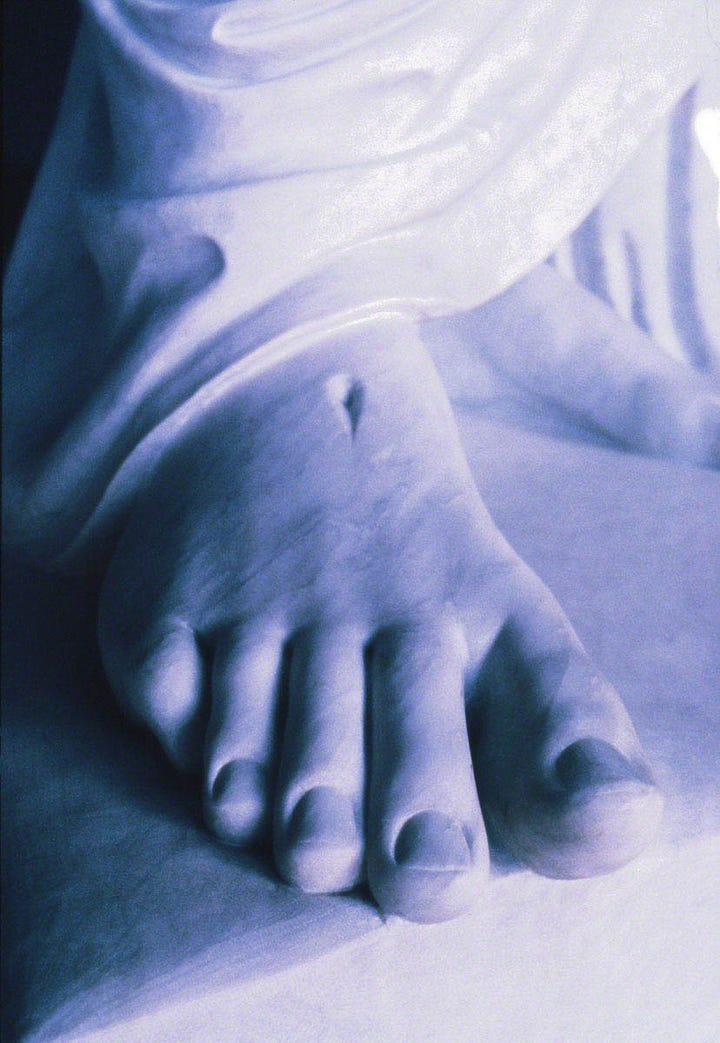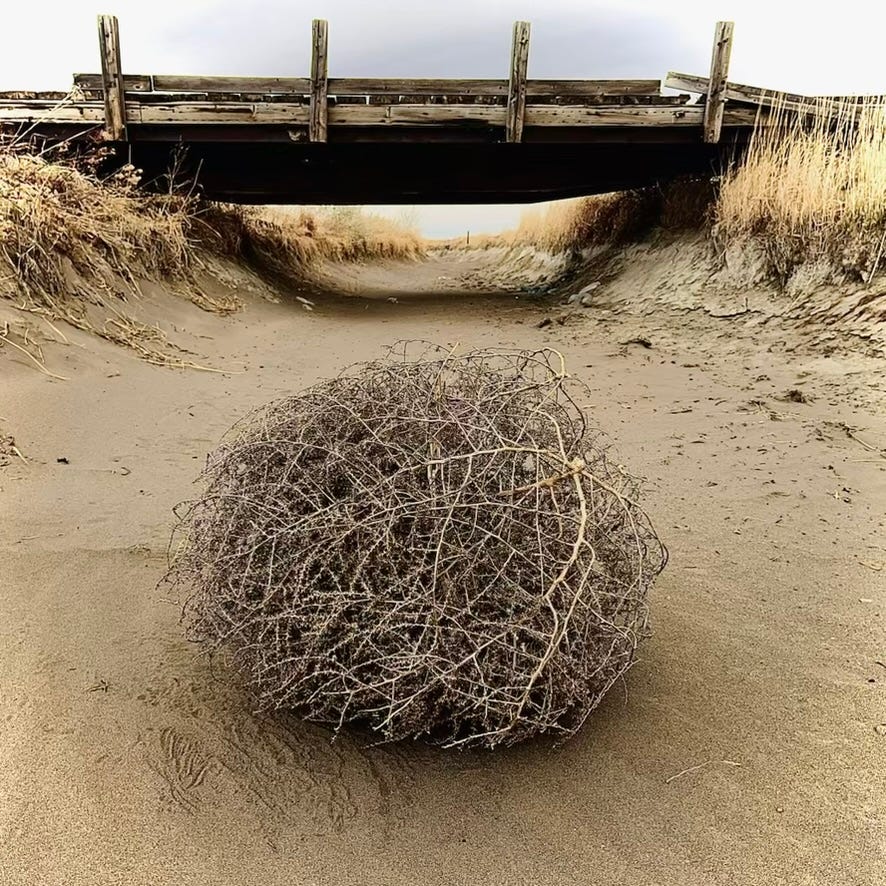The Tumbling Tumbleweed | Icon of the American West
Symbol of lonely wandering, robust endurance, and ... reminder of hope. Though no one knows what is on the road ahead, hope endures as determinedly as the iconic, roaming, indestructible tumbleweed.
About a year ago, one of my business colleagues commented that she had never seen a tumbleweed rolling along in real life. To me, it has been a common enough sight as I’ve driven countless miles in the American West (and the rest of the continental US). Yesterday, as I was running beside an empty (winterized) irrigation canal in Cody, Wyoming, near the east entrance of Yellowstone National Park, I spotted this tumbleweed bowling along its own private highway.
The oft-present winds in Wyoming’s Big Horn Basin were blowing the solo tumbleweed at quite a rapid pace along the empty canal. Serendipitously, having just passed under an old bridge, the tumbler was stopped, given a brief respite from its endless movement. The pause was just long enough for me to capture a perfectly still image. Moments later, the wind had gathered the wanderer back into its rapid gait, and it rolled jauntily past me, on to who knows where.
Since photographing that lone tumbleweed, I have been reflecting on the way this humble, not-beautiful, not-native plant has inserted itself into the folklore of the American West. It’s endless rolling carries with it themes of desolation and loneliness as counterpoints to the privileges of wild frontier freedom. Ultimately, in my mind at least, considering the tumbleweed’s frenetic pace and permanent wind-driven displacement, leads to the contemplation of the opposite — our well-grounded optimism and hope.
In Western films, literature, and art, the tumbleweed often serves as a metaphor for loneliness, abandonment, or the passage of time. Its wandering, unrooted nature mirrors the journey of drifters, cowboys, and settlers seeking their place in a vast, untamed wilderness. It’s also a cinematic shorthand for emptiness or desolation, its rolling silhouette instantly evoking a sense of quiet stillness or impending action.
In poetry and music, the tumbleweed serves as a muse. The song, Tumbling Tumbleweeds by the Sons of the Pioneers (see below) celebrates its wandering nature, turning it into a symbol of freedom and an emblem of the cowboy's roaming lifestyle. In literature, it has inspired meditations on the transient and unpredictable nature of life itself.
Interestingly, the tumbleweed (commonly Salsola tragus, or Russian thistle) is not native to North America. It is a relative newcomer, arriving, it is estimated, in the late 19th century as an unintended stowaway in flax seed shipments from Eurasia. Despite its romantic associations, it is an invasive species that thrives in disturbed soils, often connected with grazing or agriculture. It can spread rapidly, dispersing seeds as it tumbles, and occasionally becomes a nuisance by clogging fences, roads, and waterways.
Conversely, for settlers and ranchers, the tumbleweed has also symbolized survival and adaptability in an unforgiving environment. While its rapid growth and seed dispersal were problematic, it also reflected the tenacity of life in harsh conditions. For some, it even had practical uses, serving as livestock fodder in lean times.
Today, the tumbleweed remains an evocative icon of the West, appearing in popular culture in songs and poetry, and even in roadside souvenirs. It reminds us of the interplay between myth and reality in how we remember and interpret the American frontier — a blend of natural history, ecological impact, and the human imagination.
My own musings led me to two Western songs in particular.
First, the obvious, Tumbling Tumbleweeds by Sons of the Pioneers, with their beautiful harmonies —
See them tumbling down
Pledging their love to the ground!
Lonely, but free, I'll be found
Drifting along with the tumbling tumbleweeds
And then, there is a natural connection between the Sons of the Pioneers and the Roy Rogers / Dale Evans duo. That famous duo’s theme song, Happy Trails to You evokes that constant theme in Western music, the mingling of tragedy and hope.
Happy trails to you, Until we meet again. Happy trails to you, Keep smiling until then. Some trails are happy ones, Others are blue.
It's the way you ride the trail that counts, Here's a happy one for you.
Happy trails to you, Until we meet again. Happy trails to you, Keep smiling until then.
Who cares about the clouds when we're together? Just sing a song, and bring the sunny weather.
Happy trails to you, Until we meet again.
The optimism of their song, so sunny, has a tendency to mask the tragedies within their non-screen lives. Rogers and Evans, despite their fame and wealth, passed through many very real, poignant, and tragic circumstances. Thus, the rosy optimism of their theme song becomes so much more meaningful.
Both had multiple marriages before falling in love with each other. Rogers first marriage was short. His second wife died six days after giving birth. Evans had been married three times. Rogers was her fourth marriage. Not an auspicious harbinger of longevity. Yet, together, Rogers and Evans enjoyed almost 50 years of marriage and a celebrated media career until Roy Rogers passed away in 1998. Dale Evan died in 2001. Both were outspoken Christians. Their combined life experience included loss of spouse, infant death — a severely mentally retarded daughter that lived for only 2 years — and a catalogue of other challenges.
Yet, hope endured, as constantly expressed in their theme song. They adopted children from different cultures and ethnicities. They were generous in giving to, and directly sponsoring, a variety of causes. Ultimately their hope, unlike the rootless tumbleweed, was firmly rooted in faith in God.
Roy Rogers’ own words with respect to the death of their daughter, Robyn, perfectly sums up the source of his enduring hope —
“And then she was gone. Again, it was like the world had ended for all of us. But life goes on, it does, whether you want it to or not, God sees to that, and we went on too.”
The tumbling, rootless tumbleweed rolls along its endless, trackless path. In contrast, our hope endures because it is firmly rooted in God and Christ.
This reminder comes from Apostle Peter — Blessed be the God and Father of our Lord Jesus Christ, who according to His abundant mercy has begotten us again to a living hope through the resurrection of Jesus Christ from the dead, to an inheritance incorruptible and undefiled and that does not fade away, reserved in heaven for you, who are kept by the power of God through faith for salvation ready to be revealed in the last time. In this you greatly rejoice, though now for a little while, if need be, you have been grieved by various trials, that the genuineness of your faith, being much more precious than gold that perishes, though it is tested by fire, may be found to praise, honor, and glory at the revelation of Jesus Christ (NKJV 1 Peter 1:3-7).
Though iconic and symbolic, the tumbleweed has no mind. Its wanderings follow the direction and speed of the wind. We who have the ability to think, We Who Wrestle with God (the title of Jordan Peterson’s recent book), that is — all people — find ourselves challenged by the winds of life and wonder at the cause of such trials. Ultimately, no matter the burdens which often bring us to our knees, we can choose to look up with gratitude and hope because of our faith in the resurrection and life given through Jesus Christ. He said: “I am the resurrection, and the life: he that believeth in Me, though he were dead, yet shall he live (KJV John 11:25).”
In the end, the source of the wind that blows the rootless tumbleweed is the same source that grounds our faith and hope. “The wind bloweth where it listeth, and thou hearest the sound thereof, but canst not tell whence it cometh, and whither it goeth: so is every one that is born of the Spirit (KJV John 3:8).”
Thus, we are grounded, rooted, hopeful — no matter how hard the winds of life may blow — by the whisperings of the Spirit confirming a sure foundation, and a light for our feet (see KJV Psalm 119:105 — Thy word is a lamp unto my feet, and a light unto my path).








